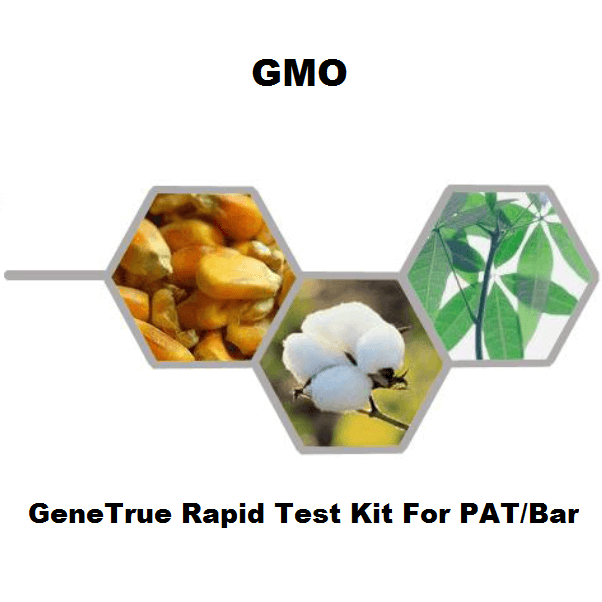INTENDED USE
The GeneTrue PAT/bar gold standard immunoassay kit is designed to be used for the rapid and qualitative detection of the herbicide-resistant transgenic PAT/bar protein in plants.
Transgenic PAT/bar protein when expressed in plants confers plant resistance to herbicides; the test kit is able to detect the presence of the PAT/bar protein expressed in transgenic plants. Experienced researchers can determine the expression level based on the color revealed on the strip test line, allowing for a qualitative or semi-quantitative analysis relative to the degree within which the PAT/bar protein is expressed in a plant.
The test will provide direct evidence of the PAT/bar protein in transgenic plants. It can be used to police unauthorized border entry, monitor phytosanitary conditions of plant imports and exports at government customs offices, and for quick screening of suspicious plants and plant products administered by food safety inspection departments.
Limit of detection : 1 ng/ml or 1 in 1000 Kernels
STORAGE
The test device in seal pouch should be stored
at 2-30ºC. Do not freeze the test device
The test device should be kept away from direct
sunlight, moisture and heat
CONTENTS
Pouch (contains: test strip and desiccant).
Test instructions.
Materials Required (Not Provided)
– Micro pipette
– Analytical Balance (1-500 mg)
– Scissors
– Grinding equipment such as a homogenizer, etc.
– Micro-centrifuge tubes or other sample collection tube
– Sample extraction bag
– Centrifuge
– Pure water
SAMPLE PREPARATION
Seeds, leaves, seedlings and other plant parts need to be ground before dilution with water. For optimal detection results, samples from different plant types should be tested with the recommended water ratios (see below). Although recommendations are given for rice and cotton plants, the test is suitable for leaves and seeds of various crops. Plant species that are not listed please select the closest category and make the appropriate dilution. Once the sample is ground and diluted with water, centrifuge or let the sample mixture settle before testing. Samples can be tested up to 3 days if stored in 4 °C. If longer time is required, it is recommended that the samples be stored at -20°C. Frequent cycles of freezing and thawing are not recommended.
1. To prepare plant leaf sample
To grind leaves, you can use a reliable sample extraction bag, or any suitable clean grinding apparatus.
• Leaves from a single plant type
Place an appropriate amount of leaves into special treatment bags for processing. Add the recommended amount of water into the bag. For example, place 0.15 g rice leaves (or 0.3 g of cotton leaves) into the sample processing bags, grind the leaves, add 3 ml of water and centrifuge or let the sample mixture settle. Aliquot a sample of the supernatant into a clean container for testing.
• Leaves from different plant types
Take equivalent amounts from each representative leaf. Using a combined weight of about 0.2 – 0.4g of leaf tissue, place into the sample processing bag, add the appropriate amount of water. Grind the leaf tissues, mix, and centrifuge or let the sample mixture settle. Aliquot a sample of the supernatant into a small, clean container for testing.
2. To prepare plant seed samples
• Seeds from a single plant type
Grind the seeds as fine as possible. Weigh 0.5 g – 2 g of ground seeds, placed in a covered tube or container, add the appropriate amount of water, shake for 2-5 minutes, and centrifuge or let the sample mixture settle. Aliquot a sample of the supernatant into a small, clean container for testing.
• Seeds from different plant types
Take equivalent amounts from each representative seed type for a combined weight of 200 g, grind as fine as possible. Weigh out 20 g – 50 g, place into a 500 ml flask or container, add the appropriate amount of water, shake for 2-5 minutes, and centrifuge or let the sample mixture settle. Aliquot a sample of the supernatant into a small, clean container for testing.
HOW TO RUN THE STRIP TEST
* Recover the kit to room temperature (15°C – 30°C ) before using.
* Remove the testing device from the foil pouch by tearing at the notch. Hold the strip at the colored end. Do not touch the arrow end or the test window (the middle part of the strip).
* Holding the strip vertically, immerse the end of the strip with the arrows into the sample liquid. Do not immerse past the MAX line.
* Take the strip out when the sample has migrated to the test window (about 10 seconds). Lay the strip (MAX side facing up) flat on a clean, dry, non-absorbent surface.
* Wait 3-5 minutes for the result. If only the control line appears, allow the strip to develop for an extra 10 minutes before making a final assay interpretation. Do not interpret the results after 30 minutes.
INTERPRETING THE RESULTS
* A positive result is the presence of two purple bands: one on the test (T) line and one on the control (C) line.
* A negative result is the presence of one purple band on the control (C) line.
* An invalid result: no band is present on the control (C) line. This may suggest the procedure was done incorrectly or the test strip was faulty. Re-test with another strip.



